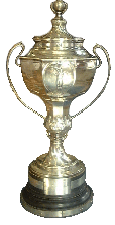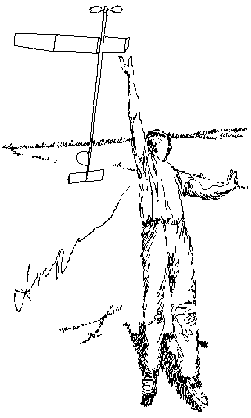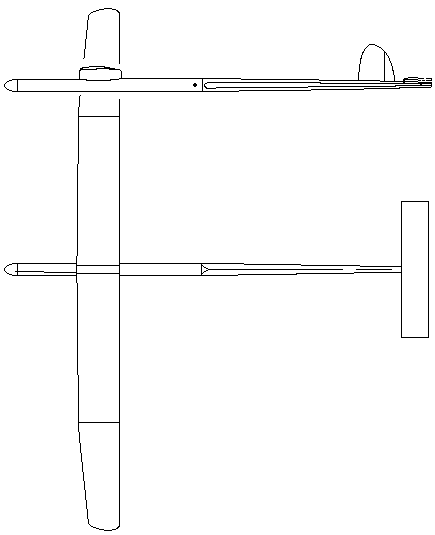Wakefield International Cup - A history from 1911 by Charles Dennis Rushing
1991 Alexander Andrjukov, 36, USSR
Indicative of Rudyard Kipling was his opening statement "There will be trouble in the Balkans." Thought of today as a given when predicting the future troubles in the world. In this case after warring with each other for centuries, the Serbians and the Croatians were again at the doorway of civil war near Zrenjanin, Yugoslavia. The same place where twenty eight nations were about to compete in the Free Flight World Champ ionships. Flying as it were "between the guns" Here to defend his title was the 1989 WC Eugeniusz Cofalik (Poland). Also present was Alexander Andrjukov (CCCP) who was second to Cofalik last year, and who was the almost perennial European Wakefield Champion. With Alex was another veteran Eugeny Gorban, and Stephan Stefanchuk. Flying this year for team USA were R Maves, G Xenakis on the team beginning in 1967 (?), and N Furutani. The Democratic Peoples Republic of Korea team was here after an absence since the Livno WC in 1985. The flying field was superb, a flat plain of low grass, with unlimited visibility, and importantly, an environment well known for its meteorological stability of clear skies, and calm windless weather patterns.
ionships. Flying as it were "between the guns" Here to defend his title was the 1989 WC Eugeniusz Cofalik (Poland). Also present was Alexander Andrjukov (CCCP) who was second to Cofalik last year, and who was the almost perennial European Wakefield Champion. With Alex was another veteran Eugeny Gorban, and Stephan Stefanchuk. Flying this year for team USA were R Maves, G Xenakis on the team beginning in 1967 (?), and N Furutani. The Democratic Peoples Republic of Korea team was here after an absence since the Livno WC in 1985. The flying field was superb, a flat plain of low grass, with unlimited visibility, and importantly, an environment well known for its meteorological stability of clear skies, and calm windless weather patterns.
The FAI/CIAM had rescinded the "...Builder of the Model Rule" (they mean "Maker," don't they?) in 1988, and even now this action was having significant reactions in the form of technological, construction, and production of Wakefield models. Balsa wood construction was now considered obsolete, and impractical for high production. Remember back in 1930, Joe Ehrhardt won the Wakefield Cup using an all balsa wood aeromodel. Ehrhardt's competition at that time believed that balsa wood was not structurally sound to resist aerodynamic stresses. They depended upon hard woods, and steel wire, covered with fabric. Composite materials were now replacing balsa wood because of their stable characteristics in all temperatures, light weight, strength, and production capabilities. These composites: carbon fibre, Kevlar, and fibreglass could be moulded, and vacuum formed by production processes to make components for motor tubes, tail booms, wings, stabilizers, rudders, and propellers. Although now a speciality of a small group of manufactures in the Eastern Block nations, the techniques of production would spread world wide, to absorb the total production of Wakefield aeromodels. To remain "competitive" by 1995 a person flying in any of the Wakefield contests in the world, would have to be flying a composite constructed model, even with the most simple controls, such as a dethermalising device. By 1995 a whole Wakefield, with every conceivable control system on board, i.e. DSP, VP, AR, VIT, WW, and DT could be purchased, pre-adjusted, ready for competition, from "Starline", a distributor for Ukrainian and Russian Wakefields. Now a person so inclined could purchase a Wakefield from "Starline", load it with good prestreched "FAI" TAN rubber, wind-it-up, run (if you can) forward, and javelin launch it into the air. Well almost, even these Wakefields require a lot of practice, but to the determined, it is easy. Are not "... the ghosts of Wakefields past..." calling out? To all of us? Probably not. Turn with me now, back to the contest at hand, The 1991 WC Wakefield International Cup event.
Turn back to the "results", which are after all, the most important part of this tale to many now, especially if you are selling "Winning Wakefield's!" Friday July 7, was Wakefield Day!
ROUND 1-7: The first round would be 210 second max, following the rule introduced before the 1989 WC. The weather at the 7:30am start was just perfect, fair skies, no to low winds, and scattered clouds. Round 1 ended not as expected, not all 65 contestants maxed the round! In fact 17 missed a max, including Xenakis (USA). By the end of the routine seven rounds, fifteen contestants had perfect scores, including the WC Eugeniusz Cofalik.
ROUND 8: The 240 second fly-off round. One contestant failed to max this round: Myong Sam Han (North Korea) was short by 37 seconds. What happened to the infamous "Thermister Man"? Who was picking air for Korea?
ROUND 9: The 300 second fly-off round, two more dropped out.
ROUND 10: The 360 second fly-off round, lopped off all but Tony Matthews (Canada), and Alex Andrjukov (CCCP) The Cup would go to one of these two. Tony's Wakefield was simple, but unlike Bob White's "Twin Fins" No. 22, it was a new composite, silver mylar covered high tech aeromodel. Alex flew a Wakefield that he was still developing, using all the bells, and whistles that were currently available, including VP, DPS, AR, VIT, WW, and DT, all driven off of a clockworks timer, which was set to go off precisely. This was not a new aeromodel, it had been successfully campaigned in contests throughout Europe.
 ROUND 11: The 420 second fly-off round. Maybe this round should have started with "...GENTLEMEN START YOUR MOTORS!" The sun was going down, visibility was becoming poor, it was 8:55pm for God's Sake! We have been flying for twelve hours and twenty-five minutes! Alex wasted no time, he was ready to go before the horn sounded to open the round! He was hooked on, and simply began winding at the signal, putting 450 knots onto his "FAI" TAN. Now he moved to the line, all the while ratcheting-in another twenty-five turns, to keep the crystals active. Alex was ready, launching his Wakefield straight up in a "javelin" throw, that would fold a balsa wing! At 20 feet the DSP kicked in with a snap, he was away! Cheers from throng!
ROUND 11: The 420 second fly-off round. Maybe this round should have started with "...GENTLEMEN START YOUR MOTORS!" The sun was going down, visibility was becoming poor, it was 8:55pm for God's Sake! We have been flying for twelve hours and twenty-five minutes! Alex wasted no time, he was ready to go before the horn sounded to open the round! He was hooked on, and simply began winding at the signal, putting 450 knots onto his "FAI" TAN. Now he moved to the line, all the while ratcheting-in another twenty-five turns, to keep the crystals active. Alex was ready, launching his Wakefield straight up in a "javelin" throw, that would fold a balsa wing! At 20 feet the DSP kicked in with a snap, he was away! Cheers from throng!
Tony was ready now. He launched by releasing his propeller with his left hand, the climb looked good! Cheers went up again. Now all watched, and waited. At 401 seconds, Tony was down. He would be second today. Alex's aeromodel DTed at 430 seconds. Alexander Andrjukov would be the first, and the last member of the CCCP team to ever win the Wakefield International Cup!
| Place | Name | Country | Round 1-7 | Round 8 | Round 9 | Round l0 | Round ll |
| 1 | A Andrjukov | CCCP | 1290 | 240 | 300 | 360 | 420 |
| 2 | T Mathews | CAN | 1290 | 240 | 300 | 360 | 401 |
| 3 | D Russell | CAN | 1290 | 240 | 300 | 353 | |
| 4 | E Cofalik (1989 WC) |
POL | 1290 | 240 | 300 | 336 | |
| 5 | S Stefpanchuk | CCCP | 1290 | 240 | 300 | 297 | |
| 6 | I Izawa | JPN | 1290 | 240 | 300 | 289 | |
| 7 | V Kubes | CS | 1290 | 240 | 300 | 247 | |
| 8 | A Siefert | GER | 1290 | 240 | 300 | 230 | |
| 9 | K Rozycki | POL | 1290 | 240 | 300 | 208 | |
| 10 | E Gorban | CCCP | 1290 | 240 | 300 | 204 | |
| Access full results | |||||||
| 1991 Team Results for Penaud Cup | ||||||
| Place | Country | Abbreviation | Total | Team member places | ||
| 1 | USSR | USSR | 3870 | 1 | 5 | 10 |
| 2 | Poland | POL | 3870 | 4 | 9 | 11 |
| 3 | China | CHN | 3778 | 12 | 21 | 32 |
| 4 | Yugoslavia | YUG | 3766 | 16 | 18 | 40 |
| 5 | Italy | ITA | 3722 | 14 | 19 | 47 |
| 6 | Czechoslovakia | CS | 3720 | 7 | 17 | 52 |
References
NFFS Aug/Sep, WC results Model Aviation, Dec 1991,
FFWC = Aeromodeller NFFS Sympo 1986, F1B, A Andrjukov
Vol Libre 89 92, Alexander Andrjukov
The fall of the Union of Soviet Peoples Republics (CCCP)
Photo caption: The javelin launch; Alexander Andrjukov's Wakefield AA-23


